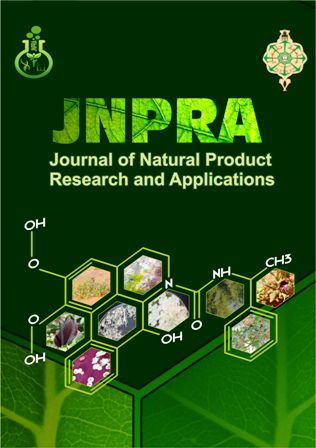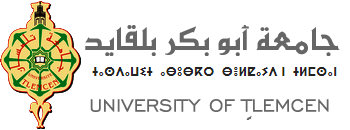In silico study of the biological properties of four sterols identified in Anabasis articulata plant
DOI:
https://doi.org/10.46325/jnpra.v4i02.78Keywords:
Anabasis articulata, Sterols, Biological activities, Molecular docking simulation, ADMET.Abstract
The search for novel therapeutics with diverse pharmacological activities has led to increased interest in natural products. In this investigation, we aim to explore the potential medicinal properties of four sterol-type molecules found in the medicinal plant Anabasis articulata (Forssk) using in silico methods. The molecules of interest are cholestanol, β-sitosterol, stigmasterol, and 26-hydroxycholesterol. To assess their therapeutic potential, we employ several theoretical methods. Firstly, molecular docking simulations are utilized to model the interactions between these molecules and target proteins associated with antioxidant, anti-inflammatory, anti-cancer, and neurodegenerative effects. The selected targets include Xanthine Oxidase (XO) for antioxidant activity, Cyclooxygenase-2 (COX-2) for anti-inflammatory effects, Estrogen Receptor Alpha (ERα) for anti-cancer properties, and Acetylcholinesterase (AChE) for neurodegenerative disorders. Visual analysis of these docking results aid in understanding the binding modes and potential mechanisms of action. Furthermore, we predict ADMET pharmacokinetic parameters and physicochemical properties to evaluate the drug-likeness of the compounds. Our findings reveal promising interactions between the sterol-type molecules and target proteins associated with various therapeutic effects. Furthermore, through rigorous evaluation of drug-likeness rules, we identify compounds with favorable structural and physicochemical characteristics for potential drug development. This comprehensive computational approach offers valuable insights into the medicinal properties of Anabasis articulataderived sterol-type molecules, paving the way for further experimental validation and pharmaceutical exploration.
References
Alam, E. A. (2011). Phytochemical screening on different plant parts of some succulent plants of Egypt. New York Science Journal, 4, 15-18. http://www.sciencepub.net/newyork.
Ali, H., Dixit, S., Ali, D., Alqahtani, S. M., Alkahtani, S., & Alarifi, S. (2015). Isolation and evaluation of anticancer efficacy of stigmasterol in a mouse model of DMBA-induced skin carcinoma. Drug design, development and therapy, 9, 2793–2800. https://doi.org/10.2147/DDDT.S83514
Amado, P. S. M., Woodley, C., Cristiano, M. L. S., & O'Neill, P. M. (2022). Recent Advances of DprE1 Inhibitors against Mycobacterium tuberculosis: Computational Analysis of Physicochemical and ADMET Properties. ACS omega, 7(45), 40659–40681. https://doi.org/10.1021/acsomega.2c05307
Ayaz, M., Junaid, M., Ullah, F., Subhan, F., Sadiq, A., Ali, G., Ovais, M., Shahid, M., Ahmad, A., Wadood, A., El-Shazly, M., Ahmad, N., & Ahmad, S. (2017). Anti-Alzheimer's Studies on β-Sitosterol Isolated from Polygonum hydropiper L. Frontiers in pharmacology, 8, 697. https://doi.org/10.3389/fphar.2017.00697
Ayaz, M., Sadiq, A., Wadood, A., Junaid, M., Ullah, F., & Zaman Khan, N. (2019). Cytotoxicity and molecular docking studies on phytosterols isolated from Polygonum hydropiper L. Steroids, 141, 30–35. https://doi.org/10.1016/j.steroids.2018.11.005
Baskar, A. A., Al Numair, K. S., Alsaif, M. A., & Ignacimuthu, S. (2012). In vitro antioxidant and antiproliferative potential of medicinal plants used in traditional Indian medicine to treat cancer. Redox report: communications in free radical research, 17(4), 145–156. https://doi.org/10.1179/1351000212Y.0000000017
Benhammou, N., Ghambaza, N., Benabdelkader, S., Atik-Bekkara, F., & Panovska, T.K. (2013). Phytochemicals and antioxidant properties of extracts from the root and stems of Anabasis articulata. International Food Research Journal, 20, 2057-2063. https://www.semanticscholar.org/paper/Phytochemicals-and-antioxidant-properties-of-from-Benhammou-Ghambaza/ee5a195d2bbae34dae503fd016871f6f135bf5ea.
Ben Menni, D., Belyagoubi-Benhammou, N., Benmahieddine, A., Ben Menni, H., Gismondi, A., Monteleone, V., Di Marco, G., D’Agostino, A., Canini, A., Benamar, H., & Atik-Bekkara, F. (2022). Identification of Sterols from Anabasis articulata (Forssk.) Moq. (Chenopodiaceae) Growing in Algeria and Study of Their Potential Bioactivity. Waste and Biomass Valorization, 13, 3283 – 3295.10.1007/s12649-022-01717-w
Cao, Z. Q., Wang, X. X., Lu, L., Xu, J. W., Li, X. B., Zhang, G. R., Ma, Z. J., Shi, A. C., Wang, Y., & Song, Y. J. (2019). β-Sitosterol and Gemcitabine Exhibit Synergistic Anti-Pancreatic Cancer Activity by Modulating Apoptosis and Inhibiting Epithelial-Mesenchymal Transition by Deactivating Akt/GSK-3β Signaling. Frontiers in pharmacology, 9, 1525. https://doi.org/10.3389/fphar.2018.01525
Dong, J., Wang, N. N., Yao, Z. J., Zhang, L., Cheng, Y., Ouyang, D., Lu, A. P., & Cao, D. S. (2018). ADMETlab: a platform for systematic ADMET evaluation based on a comprehensively collected ADMET database. Journal of cheminformatics, 10(1), 29. https://doi.org/10.1186/s13321-018-0283-x
Gabay, O., Sanchez, C., Salvat, C., Chevy, F., Breton, M., Nourissat, G., ... & Berenbaum, F. (2010). Stigmasterol: a phytosterol with potential anti-osteoarthritic properties. Osteoarthritis and cartilage, 18(1), 106-116. https://doi.org/10.1016/j.joca.2009.08.019
Ghembaza, N., Belyagoubi-Benhammou, N., & Atik Bekkara, F. (2016). Separation and identification of bioactive compounds in Anabasis articulata (Forsk) Moq. roots. Natural product research, 30(7), 857–859. https://doi.org/10.1080/14786419.2015.1065490
Gore, S., García, E. S., Hendrickx, P. M., Gutmanas, A., Westbrook, J. D., Yang, H., ... & Kleywegt, G. J. (2017). Validation of structures in the Protein Data Bank. Structure, 25(12), 1916-1927. https://doi.org/10.1016/j.str.2017.10.009
Hadri, C.N. (2015). Etude phytochimique et activité antioxydant d’extraits de plantes Sedum villosum L. (Orpin) Anabasis articulata Moq (Forssk). Thèse de doctorat. Biologie cellulaire et biochimie. Université de Tlemcen. Département de biologie. http://dspace.univ-tlemcen.dz/bitstream/112/8392/1/hadri.pdf.
Hammiche, V., Maiza, K. (2006). Traditional medicine in Central: 89–94. Sahara: pharmacopoeia of TassiliN’ajjer. Journal of Ethnopharmacology, 105(3), 358–67. https://pubmed.ncbi.nlm.nih.gov/16414225/.
Hamza, N., Berke, B., Umar, A., Cheze, C., Gin, H., & Moore, N. (2019). A review of Algerian medicinal plants used in the treatment of diabetes. Journal of Ethnopharmacology, 238, 111841. https://doi.org/10.1016/j.jep.2019.111841
Jamal, Q. M., Lohani, M., Siddiqui, M. H., Haneef, M., Gupta, S. K., & Wadhwa, G. (2012). Molecular interaction analysis of cigarette smoke carcinogens NNK and NNAL with enzymes involved in DNA repair pathways: An in-silico approach. Bioinformation, 8(17), 795–800. https://doi.org/10.6026/97320630008795.
Karim, N., Khan, I., Abdelhalim, A., Halim, S. A., Khan, A., & Al-Harrasi, A. (2021). Stigmasterol can be a new steroidal drug for neurological disorders: Evidence of the GABAergic mechanism via receptor modulation. Phytomedicine, 90, 153646. https://doi.org/10.1016/j.phymed.2021.153646.
Kerns, E. H., Di, L. (2008). Drug-like Properties: Concepts, Structure Design and Methods: From ADME to Toxicity Optimization.1erédition, Elsevier, Academic Press: Amsterdam, Boston. https://www.sciencedirect.com/book/9780123695208/drug-like-properties-concepts-structure-design-and-methods.
Kim, Y.S., Li, X.F., Kang, K.H., Ryu, B., Kim, S.K. (2014). Stigmasterol isolated from marine microalgae Navicula incerta induces apoptosis in human hepatoma Hep G2 cells. BMB Reports, 47(8): 433–438. 10.5483/BMBRep.2014.47.8.153
Kim, S., Chen, J., Cheng, T., Gindulyte, A., He, J., He, S., Li, Q., Shoemaker, B. A., Thiessen, P. A., Yu, B., Zaslavsky, L., Zhang, J., & Bolton, E. E. (2019). PubChem 2019 update: Improved access to chemical data. Nucleic Acids Research, 47(D1), D1102-D1109. https://doi.org/10.1093/nar/gky1033
Le, J. (2019). Distribution des médicaments dans les tissus. In: Édition professionnelle du Manuel MSD. "Distribution des médicaments dans les tissus - The Merck Manuals." https://www.merckmanuals.com/fr-ca/professional/pharmacologie-clinique/pharmacocin%C3%A9tique/distribution-des-m%C3%A9dicaments-dans-les-tissus.
Li, X., Xin, Y., Mo, Y., Marozik, P., He, T., & Guo, H. (2022). The Bioavailability and Biological Activities of Phytosterols as Modulators of Cholesterol Metabolism. Molecules (Basel, Switzerland), 27(2), 523. https://doi.org/10.3390/molecules27020523
Metwally, N. S., Mohamed, A. M., & ELSharabasy, F. S. (2012). Chemical constituents of the Egyptian Plant Anabasis articulata (Forssk) Moq and its antidiabetic effects on rats with streptozotocin-induced diabetic hepatopathy. Journal of Applied Pharmaceutical Science, (Issue), 54-65. 10.7324/JAPS.2012.2403
Mohammed, H. A., Alshalmani, S. K., & Abdellatif, A. G. (2013). Antioxidant and quantitative estimation of phenolics and flavonoids of three halophytic plants growing in Libya. Journal of Pharmacognosy and Phytochemistry, 2(3), 89-94. https://dx.doi.org/10.22271/phyto
Naili, O. (2016). Effet des extraits de Abies numidica de Lannoy sur la croissance et sur la microflore caecale et fécale des poussins de chair. Thèse de doctorat. Microbiologie. Université Ferhat Abbas Sétif 1. Faculté des Sciences de la Nature et de la Vie. Département de microbiologie. http://dspace.univ-setif.dz:8888/jspui/bitstream/123456789/1633/1/Naili%20Oumaima.pdf.
Naspiah, N., & Pratama, M. R. F. (2021). Xanthine oxidase inhibition activity and ADMET properties of terap (Artocarpus odoratissimus Blanco) leaves metabolites: Phytochemical screening and in silico studies. Pharmacognosy Journal, 13(5). 10.5530/pj.2021.13.148
Nattagh‐Eshtivani, E., Barghchi, H., Pahlavani, N., Barati, M., Amiri, Y., Fadel, A., ... & Ghavami, A. (2022). Biological and pharmacological effects and nutritional impact of phytosterols: A comprehensive review. Phytotherapy Research, 36(1), 299-322. doi: 10.5530/pj.2021.13.148
Pratiwi, R., Nantasenamat, C., Ruankham, W., Suwanjang, W., Prachayasittikul, V., Prachayasittikul, S., & Phopin, K. (2021). Mechanisms and Neuroprotective Activities of Stigmasterol Against Oxidative Stress-Induced Neuronal Cell Death via Sirtuin Family. Frontiers in nutrition, 8, 648995. https://doi.org/10.3389/fnut.2021.648995
Pettersen, E. F., Goddard, T. D., Huang, C. C., Meng, E. C., Couch, G. S., Croll, T. I., ... & Ferrin, T. E. (2021). UCSF ChimeraX: Structure visualization for researchers, educators, and developers. Protein Science, 30(1), 70-82. https://doi.org/10.1002/pro.3943
Qian, Z., Fields, C. J., Yu, Y., & Lutz, S. (2007). Recent progress in engineering alpha/beta hydrolase-fold family members. Biotechnology Journal, 2(2), 192–200. https://doi.org/10.1002/biot.200600186
Shahzad, N., Khan, W., Shadab, M. D., Ali, A., Saluja, S. S., Sharma, S., ... & Al-Ghamdi, S. S. (2017). Phytosterols as a natural anticancer agent: Current status and future perspective. Biomedicine & Pharmacotherapy, 88, 786-794. https://doi.org/10.1016/j.biopha.2017.01.068
Sun, Y., Gao, L., Hou, W., & Wu, J. (2020). β-Sitosterol Alleviates Inflammatory Response via Inhibiting the Activation of ERK/p38 and NF-κB Pathways in LPS-Exposed BV2 Cells. BioMed research international, 7532306. https://doi.org/10.1155/2020/753230
Trott, O., & Olson, A. J. (2010). Auto Dock Vina: improving the speed and accuracy of docking with a new scoring function, efficient optimization, and multithreading. Journal of computational chemistry, 31(2), 455–461. https://doi.org/10.1002/jcc.21334
Valko, M., Leibfritz, D., Moncol, J., Cronin, M. T., Mazur, M., & Telser, J. (2007). Free radicals and antioxidants in normal physiological functions and human disease. The International Journal of Biochemistry & Cell Biology, 39(1), 44–84. https://doi.org/10.1016/j.biocel.2006.07.001
Veber, D. F., Johnson, S. R., Cheng, H. Y., Smith, B. R., Ward, K. W., & Kopple, K. D. (2002). Molecular properties that influence the oral bioavailability of drug candidates. Journal of Medicinal Chemistry, 45(12), 2615–2623. https://doi.org/10.1021/jm020017n
Wang, N. N., Dong, J., Deng, Y. H., Zhu, M. F., Wen, M., Yao, Z. J., ... & Cao, D. S. (2016). ADME properties evaluation in drug discovery: prediction of Caco-2 cell permeability using a combination of NSGA-II and boosting. Journal of Chemical Information and Modeling, 56(4), 763-773. https://doi.org/10.1021/acs.jcim.5b00642
Yalcin, S. (2020). Molecular Docking, Drug Likeness, and ADMET Analyses of Passiflora compounds as P-glycoprotein (P-gp) inhibitor for the treatment of cancer. Current Pharmacology Reports, 6, 429-440. https://doi.org/10.1007/s40495-020-00241-6
Yoshida, Y., & Niki, E. (2003). Antioxidant effects of phytosterol and its components. Journal of nutritional science and vitaminology, 49 (4), 277–280. https://doi.org/10.3177/jnsv.49.277
Zhang, C., Zhou, Y., Gu, S., Wu, Z., Wu, W., Liu, C., ... & Tang, Y. (2016). In silico prediction of hERG potassium channel blockage by chemical category approaches. Toxicology Research, 5(2), 570-582. https://doi.org/10.1039/c5tx00294j
Zaretzki, J., Matlock, M., & Swamidass, S. J. (2013). XenoSite: accurately predicting CYP-mediated sites of metabolism with neural networks. Journal of chemical information and modeling, 53(12), 3373–3383. https://doi.org/10.1021/ci400518g
Downloads
Published
Issue
Section
License

This work is licensed under a Creative Commons Attribution-NonCommercial 4.0 International License.






